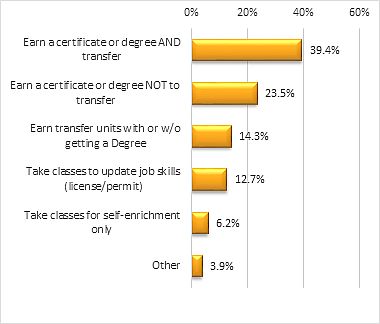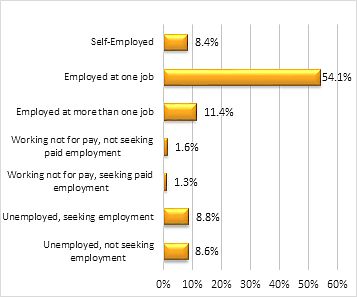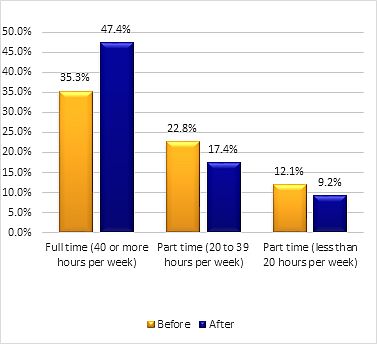Results
Respondents were asked their primary reason for studying, and the majority (62.9%) indicated earning a certificate or degree (with or without transfer). Figure 1 shows the results.
Figure 1. Primary reason for studying

Respondents were asked why they stopped taking classes. Here are the most frequently cited reasons, in rank order of frequency:
- My goals were met (6,865)
- I completed the program (6,113)
- Transferred to another school (4,373)
- I got a job (3,800)
53.0% of former students were “very satisfied” with the education and training they received, and 38.4% were “satisfied” for an overall satisfaction rate of 91.3%.
40.0% of respondents indicated they had transferred to another College or University.
73.9% of respondents are employed for pay. Figure 2 shows the results.
Figure 2. Current Employment Status

Overall, statewide, students who transferred have 1.9 times the likelihood of being unemployed and not seeking employment (6.2% for not transferring vs. 12.0% for transferring), likely because they are enrolled at a four year institution.
Respondents were asked, if currently employed, how closely related their job is to their field of study. 45.0% indicated they are working in the same field as their studies and training, followed 24.4% indicating they work in a field that is “close” to their studies and training, and 30.6% indicated their job is not related to their studies. When asked if they were actively seeking a job in another field, 77.1% of employed respondents said no.
Of those respondents who engaged in a job search after finishing their studies, 79.4% reported finding a job and 20.6% were still looking. Of those with a successful job search, 81.7% found a job within six months (65.2% within three months).
Of currently employed respondents, 17.1% had been employed at their current job less than six months, 16.8% between six months and one year, 23.6% between one and two years, 13.2% between two and three years and 29.4% had been employed at their current job for more than three years.
Before their studies, 35.3% of respondents worked full time. After completing their studies, 47.4% work full time. Figure 3 shows the results.
Figure 3. Work status before studies/training and after

The hourly wage of all respondents increased 34.1% from their hourly wage before their studies ($18.07) to their hourly wage after completing their studies ($24.24). Figure 4 shows the results.
Figure 4. Earnings before studies/training and after

Respondents, including those who had transferred, were asked what impact their coursework had on their employment. Here are the responses, listed in rank order of frequency:
- Prepared me for a possible new job (3,207)
- Enabled me to learn skills that allowed me to get a job at a new organization (2,382)
- No impact on my employment (1,840)
- Enabled me to learn skills that allowed me to stay in my current job (1,531)
- Enabled me to learn skills that allowed me to get a promotion at my same organization (1,061)
- Enabled me to start my own business (584)
Summary and Conclusions
The results of the survey showed that completing CTE studies and training – whether or not a credential is earned, whether or not a student transfers – is related to positive employment outcomes. The preponderance of respondents are employed, are working in the same field as their studies or training, and are working full time. Respondents overall posted a 34.1% increase in their hourly wage after completing their studies and the vast majority were satisfied with the education and training they received.